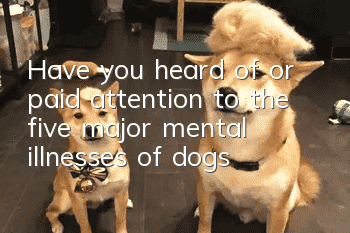Have you heard of or paid attention to the five major mental illnesses of dogs?

From an evolutionary perspective, the anatomical structure and physiological basis of mammals are very similar, so many researchers believe that animals may also suffer from psychological problems similar to humans. Not only depression, but also anxiety, phobia, obsessive-compulsive disorder (OCD), post-traumatic stress disorder (PTSD), etc. may appear in animals~
1. Depression
It is actually difficult to say whether animals will suffer from depression. Even for human depression, the diagnostic procedures are mostly based on some very subjective indicators, including that the person often feels guilty, has suicidal tendencies, and has negative feelings about anything. Things are of no interest and so on. Animals cannot speak. Even if there are changes in physical and mental state that are similar to depression in humans, it is often difficult for parents to observe them. Most of them will only think that the little one has grown up and his personality has become calmer.
2. Obsessive Compulsive Disorder (OCD)
This is an animal psychological abnormality that we often mention, and it is easy to be noticed and recognized by the owner. Although the symptoms displayed by each animal are different, they all share the common characteristic of aimlessly repeating an action or behavior.
1. Chasing one’s own tail:
2. Excessive self-grooming:
3. Stereotyped behaviors of caged animals (pacing, shaking head, etc.):
4. Parrot’s feather plucking behavior:
Perhaps these actions are interesting at first glance, but these animals will repeat this action all day long, even without eating, drinking or sleeping. In extreme cases, they will cause serious self-injury to themselves. In fact, they are an urgent need. Treatment of mental illness states.
3. Anxiety and Phobia
Anxiety and fear themselves are very conducive to survival emotions. When animals encounter danger, these emotions can keep them alert and alert and avoid danger as quickly as possible. The problem is that some animals still show anxiety and fear even when there is no threat, which will have many negative impacts on their lives. The most typical example is separation anxiety in cats and dogs.
When animals feel extremely anxious and cannot calm down, they often take some extreme behaviors, such as tearing down homes, barking, even rushing around, jumping from high places, etc., which can easily injure themselves.
4. "Hypothetical" syndrome
It is also one of the manifestations of anxiety. Typical symptoms include catching flying insects that do not exist in the air, or aiming at something.There is no alley roar.
There are also some animals that are overly afraid of specific things, such as cars, firecrackers, people wearing hats, and even small balls, stuffed toys and other seemingly harmless items. This is not necessarily because they have been stimulated by something, just like people who are afraid of snakes may not have actually been bitten by snakes. The specific cause of fear is difficult to trace. Even two dogs raised in the same household may be afraid of different things. Occasionally being frightened is harmless, but some animals are so fearful that they don't even dare to go out. They are always nervous, hiding everywhere, and living in fear every day.
5. Post-Traumatic Stress Disorder (PTSD)
Although this psychological abnormality has not yet been recognized in animals, many behavioral experts believe that this condition is real and even quite common.
I believe many of my friends have heard stories of service dogs helping retired soldiers with PTSD return to normal lives, but they have never thought that military dogs returning from the battlefield may also suffer from similar psychological abnormalities. Military dogs retired from conflicts in Iraq and Afghanistan were found to have symptoms of suspected PTSD after returning to the United States. These dogs are extremely sensitive and are afraid of jumping into cars or being near bearded men, making it difficult for them to return to their normal lives.
Warm reminder:
Having introduced so many mental illnesses in animals, what should we do if the animals around us really suffer from these conditions?
Many parents will choose to seek professional help, which is very worthy of encouragement. Usually, veterinarians and behavioral trainers will help parents develop solutions based on the principle of combining "behavior modification" and "drug treatment".
In addition to following professional advice, the most important thing parents can do is to accompany them. Just like service animals that assist in the treatment of human mental illnesses, when animals have psychological problems, we need to provide them with help.
- How does a novice train a pet dog? How to train a pet dog!
- What are the symptoms of a cold in dogs?
- How to tell the difference between a Maltese and a Shih Tzu? What's the difference between them?
- How to train a dog not to eat randomly outside? How to train dogs to pick up food
- What are the key points for raising Mastiff dogs?
- How to train Russian Shepherd Dog
- With good training, the dog will not reject it and have more freedom in life!
- Common reproductive system diseases in dogs
- What injections do dogs get once a year?
- What are the early symptoms of pancreatitis in dogs?



